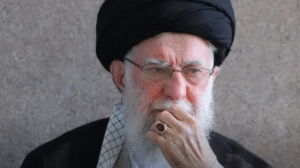In Shadow of Threats, Iran’s Supreme Leader Reportedly Appoints Three Potential Successors ; Tehran, Iran
 In a move that could reshape the future of the Islamic Republic, Iran’s Supreme Leader Ayatollah Ali Khamenei has reportedly appointed a trio of high-ranking clerics to potentially succeed him, amid heightened tensions with Israel and renewed threats from former U.S. President Donald Trump.
In a move that could reshape the future of the Islamic Republic, Iran’s Supreme Leader Ayatollah Ali Khamenei has reportedly appointed a trio of high-ranking clerics to potentially succeed him, amid heightened tensions with Israel and renewed threats from former U.S. President Donald Trump.
According to confidential sources close to Iran’s ruling elite and reports circulating in Persian-language media, Ayatollah Khamenei, now 86 and facing increasing health concerns, has preemptively designated a list of three vetted successors. The reported appointments come at a time of acute regional volatility, with Tehran locked in proxy confrontations with Israel and grappling with the aftershocks of geopolitical pressure from the West.
Though Iranian state media has not officially confirmed the report, analysts believe the decision was driven by both internal power dynamics and external threats to the leadership’s continuity.
A Quiet Succession Plan
Sources indicate that the Supreme Leader, who has ruled since 1989 following the death of Ayatollah Ruhollah Khomeini, held closed-door consultations with the Assembly of Experts — the clerical body constitutionally responsible for choosing the next Supreme Leader — before outlining his preference for three trusted clerics.
While the exact names of the appointees remain unverified, speculation centers around:
- Ebrahim Raisi, the late president of Iran who had long been seen as a frontrunner before his sudden death in a helicopter crash in May 2024;
- Ayatollah Alireza Arafi, head of Iran’s seminaries and an influential member of the Guardian Council;
- Mojtaba Khamenei, the Supreme Leader’s son, who wields considerable influence behind the scenes and is reportedly being groomed for higher authority despite concerns about hereditary succession.
This quiet but strategic maneuver by Khamenei is seen as an attempt to secure ideological continuity within the regime and prevent a destabilizing power vacuum.
Mounting External Threats
The reported appointments come at a time of mounting threats from abroad. Israel, citing Iran’s continued support for Hezbollah and its alleged acceleration of uranium enrichment activities, has intensified its rhetoric, with senior Israeli officials suggesting that the days of Iran’s top leadership “are numbered.”
Meanwhile, former U.S. President Donald Trump, currently in the midst of his reelection campaign, recently issued a controversial statement on social media warning that Ayatollah Khamenei “won’t live forever” and accusing him of being “behind decades of terrorism.”
The remarks have reignited fears in Tehran of a targeted assassination or regime decapitation strategy, similar to the U.S. drone strike that killed Iranian General Qasem Soleimani in 2020. Iranian officials swiftly condemned Trump’s statement as “an open threat of terrorism” and warned of severe consequences if any action is taken against its leadership.
“Such reckless threats only underscore why Iran must ensure a strong and seamless transition of power,” said Dr. Sadegh Zibakalam, a prominent Iranian political analyst. “The Supreme Leader’s decision to appoint successors now is as much about domestic stability as it is about responding to foreign threats.”
A Delicate Balancing Act
Iran’s constitution allows for the appointment of a Supreme Leader by consensus of the Assembly of Experts, but Khamenei’s move to pre-select a shortlist suggests a push to influence that decision even from beyond the grave. While the Assembly technically holds the final say, political observers believe its members are heavily aligned with Khamenei’s ideology and will likely endorse his preferences.
However, divisions remain within the clerical establishment and the wider population, particularly among reformists who advocate for a less rigid interpretation of Islamic governance. The appointment of successors seen as hardliners may deepen internal dissent, especially among Iran’s youth, many of whom are disillusioned with the current regime.
Regional and Global Implications
The geopolitical consequences of Khamenei’s reported succession planning are significant. A change in Iran’s top leadership could alter the tone of its foreign policy, particularly its stance toward the West and its role in proxy conflicts in Syria, Iraq, Lebanon, and Yemen.
U.S. intelligence agencies and Israeli defense officials are closely monitoring the developments, concerned about both the power struggle that could ensue and the potential for Iran’s Revolutionary Guard Corps to play a larger role in governance during any leadership transition.
As Iran stands at a historic crossroads, the decisions made in the coming months will likely determine not only the future of the Islamic Republic, but also the trajectory of stability in the broader Middle East.